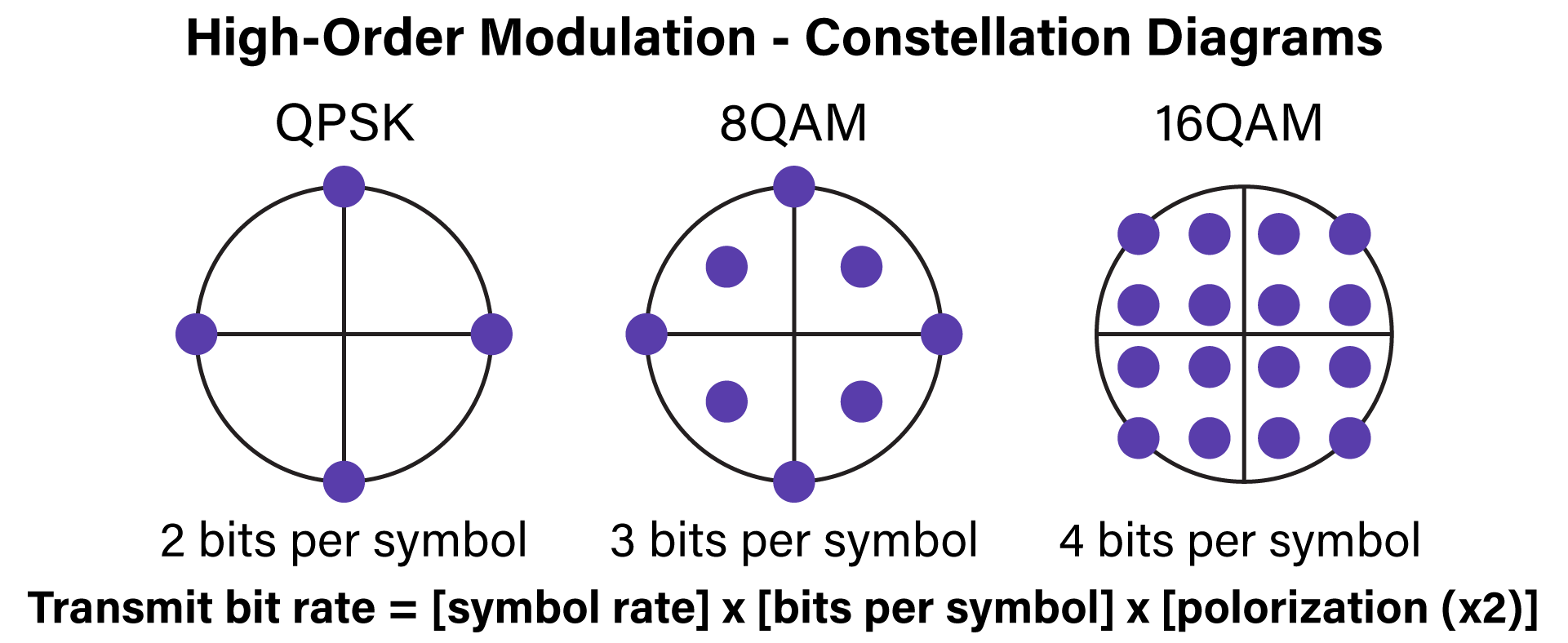Coherent Optics: What’s all the Fuss About?
Posted by Tim Yanda on Nov 21, 2022

We are hearing the term “Coherent Optics” used liberally in relation to high bitrate transceivers – 200G, 400G, 800G and higher. So, what is a Coherent Optic?
Coherent Optical Transmission is a technique that uses modulation of the amplitude and phase of the light, as well as transmission across two polarizations, to enable the transport of considerably more information through a fiber optic cable. While this is a short answer to a highly evolved device that allows for substantial bandwidth, thinking back to our blog on NRZ and PAM4 we saw that PAM4 added two additional symbols (for a total of four) from the traditional two symbols in NRZ.
Now, Coherent Transmission adds in higher order modulation techniques encoding information into both the phase, amplitude, and polarization of the light signal – rather than just the intensity as in NRZ.
By including the additional polarizations of a carrier, other symbols can be calculated, allowing for higher bit rate transmissions.

Diagram courtesy of Accton Corp.
However, this is a much more precise method of signal transmission that requires additional encoding and decoding to ensure the symbols are understood. Digital Signal Processing (DSP) is required at both the transmitter and receiver to ensure this precision occurs.
In the early iterations of Coherent Optics, the DSP was in the switch port and required both ends to be the same DSP in order to function. These systems were referred to as Analog Coherent Optics (ACO). The next step was Digital Coherent Optics (DCO). With DCO parts, the DSP was moved into the transceiver – but still required a matching pair to function properly.
The latest versions of DCO parts are moving towards full interoperability across DSPs:

Diagram courtesy of Accton Corp.
Improvements in modulation techniques has allowed not only greater bandwidth but farther distances across standard Single-Mode Fiber (SMF) networks. The 400ZR agreements supported by the OIF (Optical Internetworking Forum) and IEEE (Institute of Electrical and Electronics Engineers) are allowing for 80km to 120km distances to occur. One key is the change from 4 Quadrature Amplitude Modulation to 8QAM to 16QAM, which will shorten the effective range of the parts. The 400ZR/ZR+ standard is targeted at 80km to 120km.
Worth noting at this point: a 400ZR QSFP-DD module is drawing close to 16 watts of power – a rather power-hungry device for a traditional Ethernet switch to support.
The advent of lower cost DSPs, as well as interoperability standards by the OIF and IEEE, are allowing advances in 200G to 400G to 800G transmission rates to be built into QSFP and OSFP form factor transceivers. The key to longer distances is clean fiber, and the precise engineering of circuits.
The good news with the use of QAM modulation is you can set the part for 8QAM and deliver 200G of bandwidth as needed to change the modulation scheme to 16QAM and support 400G of bandwidth.
Of note: as these changes are made, the fiber needs to be checked (characterized) to ensure it will support the higher precision required.
As you can tell, coherent processors require a higher degree of sophistication than the traditional NRZ optical transceiver. The need to account for dispersion effects, compensating for CD (Chromatic Dispersion) and PMD (Polarizations Mode Dispersion) are key attributes of a DCO transceiver. Also, improved tolerances for Polarization-Dependent Loss (PDL) and State of Polarization (SOP) help avoid bit-errors due to cycle slips that would otherwise affect optical performance. The need for high-gain soft-decision Forward Error Correction (FEC) is further indication that these are not simple devices.
The great news out of all this alphabet soup of optical terms is a DCO transceiver that is well designed and equipped to support much higher bit rates over longer distances from a traditional Ethernet switch. The simplification brought by the OIF and IEEE interoperability committees is allowing DCO transceivers to move into the mainstream of high bandwidth affordable transceivers.
We will be adding options to our roadmap as they become available. Next stop: 800G!
In the meantime, you can read Part 2 About Coherent Optics >>



